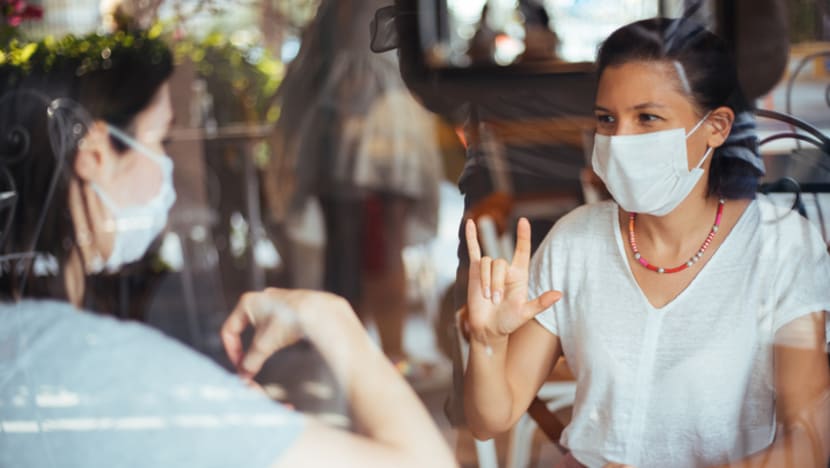Commentary: Don’t feel sorry for my deaf parents, communicate with them
Children of deaf adults feel the pressure of being their voice and ears, but like other hearing people, risk underestimating what deaf individuals are capable of, says a writer.

Two women speak in sign language. (Photo: iStock/agrobacter)
SINGAPORE: During my adolescence, I told friends or acquaintances my parents were deaf only when I really had to. Most times, it was minutes before they were due to meet.
People would say they were sorry or marvel at how I “overcame odds” – reactions I understood, but disliked because they implied I had a lesser life because of my parents.
These experiences have become talking points on the back of the movie CODA (an acronym for children of deaf adults) snagging three Oscars a few weeks ago, including the coveted Best Picture award.
The Apple TV+ film has been praised for its authenticity in casting deaf actors who have lived experience with American Sign Language. Troy Kotsur won Best Supporting Actor for his role as the main character’s father, becoming the first deaf man to win an Oscar for acting.
CODA tells the story of a young woman, Ruby, torn between her obligations to her deaf family and her dreams to study at a music college.
Many scenes hint at Ruby family’s over-reliance on her, extending to their fishing business. Their boat is not allowed to operate without a hearing individual on board, so she trades in after-school singing practices for work. On land, she is her family’s voice, bartering fish at the market and interpreting for her parents at media functions.
My siblings and I have been made unwilling middlemen who – as young children – had to call up and demand solutions from service providers, tell adult waiters we did not like the food, and relay comments about ourselves at parent-teacher conferences.
But we were never made to feel like the world weighed on our shoulders. Adult responsibilities like jobs and bills were their own. This was a conscious decision, my mom said, as she had seen how obligations turned into resentment for an acquaintance.
Their opinions are closer to that of Leo, Ruby’s brother. Unlike his parents, Leo is reluctant to depend on her. When Ruby decides to put her aspirations on pause for the family, he chides her: “You’re so afraid that we’d look stupid. Let [hearing people] figure out how to deal with deaf people! We’re not helpless.”
His remarks mirror earlier conversations my parents had with my siblings and me. Like Ruby, I’ve felt the pressure to protect my parents by being their voice and ears; but in doing so, I had been unintentionally condescending to them. When being their voice, I had thought I knew better and often spoke for them without cueing them into the full conversation, as I assumed their answers.
AN UNIMAGINATIVE, IMPATIENT HEARING WORLD
CODA also lays bare many of my parents’ gripes about the hearing world, which in their eyes, lacks patience and imagination.
They see it in food vendors who would yell at them instead of taking the time to understand their gesturing, or at a systemic level, organisations that insist on customer service via phone calls. My dad once went to a telco provider’s headquarters to sort a phone bill issue, only to find it conducted customer service by talking through web-cameras.
They see it in limitations imposed upon them, by people who cannot imagine life with sound. My parents spoke of lost opportunities, not for want of capability, but accessibility. Job promotions were hard to come by because they were excluded from meetings and watercooler conversations.
In Singapore, access services like interpreting or notetaking are subsidised but not completely free. It’s also impractical to have a deaf person always accompanied by an interpreter. Many would make do with hearing aids or accept the attrition in information.
As children, my parents attended the now-defunct Singapore School for the Deaf, and were exposed to two teaching philosophies: One required them to learn to wear hearing aids, speak and lip-read; the other was communicating via sign language.
Hearing aids make uncomfortable noises and lip-reading is exhausting, so my parents opt to sign. They describe learning sign language as the moment they found their voice, when they no longer felt at loss for words. English is odd, they tell me. Its syntax follows a rhythm unnatural to them.
To them, English is the equivalence of a second language, and Singapore Sign Language is their native one.
People I’ve come across are often surprised to find out that a sign language is not a literal translation of the spoken language. While there are some versions that are, like Signing-Exact-English Sign Language, most are languages in their own right, depictive of the people and culture in that deaf community.
Some circles refer to it as a three-dimensional language, for its length, depth and breath. One’s facial expressions, body language and space they use are integral to signing. Sign languages are so vivid and colourful, I find that I dull stories in interpreting them into English.
SLOWING DOWN THE HEARING WORLD
I often wonder how much better my parents’ lives would be if most people were willing to slow down and listen with their eyes. Most times – at least for my parents and their deaf friends – don’t expect strangers to know sign language, and will use basic gestures to get their point across. All it takes is some patience and imagination, like in charades.
For example, my grandma who does not know sign language, comes up with some of the most ingenious signs to communicate with my parents. Once, to say the word “Japan”, she drew a circle in the air, then turned her hand perpendicular to her wrist, and waved it. She was describing the Japanese flag, and it worked.
The Singapore Association for the Deaf estimates about 500,000 people with hearing loss in Singapore. According to the World Health Organization, over 5 per cent of the world’s population have hearing loss that require hearing rehabilitation. Why shouldn’t we rethink how things are done to include a sizeable chunk of the population?
Must deaf people put on hearing aids, learn to speak or get an interpreter to fit in our world, or must – as Leo put it – “hearing people figure out how to deal with deaf people”? It is accessibility on our (hearing people) own terms, after all.
But I say this with a caveat, the deaf community is expansive and heterogenous. My family’s experiences and wants cannot speak for the rest.
Some camps of deaf people are perfectly happy to adapt to the hearing world. Other deaf people – including my parents – take pride in their language and culture, and are referred to with an uppercase Deaf.
Regardless of the camp they belong to, if a deaf person is attempting to communicate with gestures let’s take the time to engage them in the chosen medium. They adapt to our world all the time.
These days, I have had fewer new people to introduce to my parents. But when I do, I hope they can do more than fluster and wave.
Christalle Tay works at the National University of Singapore as an analyst. This commentary was written in a personal capacity.


















